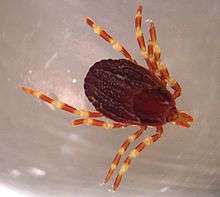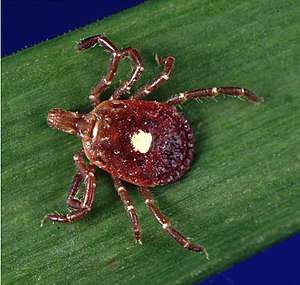Hyalomma
Hyalomma is a genus of hard-bodied ticks common in Asia, Europe, and North Africa. They are also found in Southern Africa. The name is derived from Greek: hyalos (ὕαλος) crystal, glass; and omma (oμμα) eye.
| Hyalomma | |
|---|---|
 | |
| Hyalomma marginatum specimen in alcohol | |
| Scientific classification | |
| Kingdom: | |
| Phylum: | |
| Class: | |
| Subclass: | |
| Superorder: | |
| Order: | |
| Family: | |
| Subfamily: | Hyalomminae |
| Genus: | Hyalomma |
| Species | |
|
See text | |
Hyalomma originated from Iran or the southern part of the former Soviet Union and spread into Asia, the Middle East, southern Europe, and Africa (Larry S. Roberts, 2009).
Hyalomma are larger in size and do not have protective shields (indistinct festoons), but have eyes and banded legs. Hyalomma species are difficult to identify due to their hybridization and genetic and morphological variations, caused by harsh environmental conditions and lack of food sources. Hyalomma species are the only ticks to live in such harsh desert conditions. With few hosts available, they are required to be active as soon as a potential host is sensed.
Adult Hyalomma can bite humans and transmit serious pathogens. Immature (nymph) Hyalomma usually feed on birds, rodents, and hares and can be the cause of viral disease and rickettsias. Nymphs are often transmitted from one place to another by migrating birds. For example, a migrating bird carrying a Hyalomma marginatum nymph can cause Crimean-Congo hemorrhagic fever (Larry S.Roberts, 2009). Hyalomma species can also transmit rickettsias like Siberian tick typhus, Boutonneuse fever, and Q fever (Larry S.Roberts, 2009).
Species
- Hyalomma aegyptium Linnaeus, 1758
- Hyalomma albiparmatum Schulze, 1919
- Hyalomma arabica Pegram, Hoogstraal & Wassef, 1982
- Hyalomma brevipunctata Sharif, 1928
- Hyalomma dromedarii Koch, 1844
- Hyalomma erythraeum Tonelli-Rondelli, 1932
- Hyalomma franchinii Tonelli-Rondelli, 1932
- Hyalomma hussaini Sharif, 1928
- Hyalomma hystricis Dhanda & Raja, 1974
- Hyalomma impeltatum Schulze & Schlottke, 1930
- Hyalomma impressum Koch, 1844
- Hyalomma kumari Sharif, 1928
- Hyalomma lusitanicum Koch, 1844
- Hyalomma marginatum Koch, 1844
- Hyalomma nitidum Schulze, 1919
- Hyalomma punt Hoogstraal, Kaiser & Pedersen, 1969
- Hyalomma rhipicephaloides Neumann, 1901
- Hyalomma schulzei Olenev, 1931
- Hyalomma scupense Schulze, 1919[1]
- Hyalomma sinaii Feldman-Muhsam, 1960
- Hyalomma truncatum Koch, 1844
- Hyalomma turanicum Pomerantsev, 1946
References
- Gharbi, M.; Darghouth, M.A. (2014). "A review of Hyalomma scupense (Acari, Ixodidae) in the Maghreb region: from biology to control". Parasite. 21: 2. doi:10.1051/parasite/2014002. PMC 3917376. PMID 24507485.
Further reading
- Roberts, Larry S., John Janovy, Gerald D. Schmidt, and Steve Nadler. "Chapter 41: Parasitic Arachnids: Subclass Acari, Ticks and Mites." Gerald D. Schmidt & Larry S. Roberts' Foundations of Parasitology. 8th ed. New York: McGraw-Hill, 2009. 645. Print.
